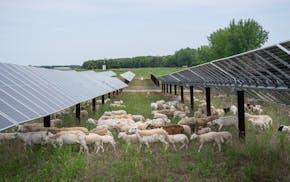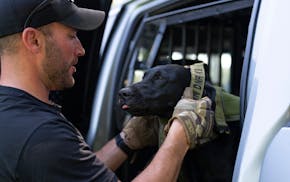CLEAR LAKE, MINN. — Sheep clambered out of a trailer, rushed down a ramp and spilled into a field of knee-high grass covered by rows of solar panels. Some leaped as they exited, joining the chorus of bleats and laughter from the humans watching.
The animals deployed Thursday morning are Xcel Energy's newest and perhaps most adorable workers, carrying out the important task of keeping plants away from solar panels.
"It's keeping the veg down, pretty much eating anything that's green on the ground," said Luke Molus, Xcel Energy's operations manager for the Sherco solar site. "It keeps the veg out of the panels, out of the wiring."
The grazing project at Xcel's Sherco solar project is the latest — and biggest — example of a movement in Minnesota to improve habitat at solar farms and and pair energy production with agriculture.
Sherco is already Minnesota's largest solar farm, built to help replace the power lost as Xcel's coal plant next door in Becker closes in phases by 2030. The solar farm will get even bigger, after state regulators last year approved an expansion.
Xcel expects as many as 2,500 sheep to mow its ground cover of pollinator and wildlife friendly plants for months every year.
"It is really a burgeoning thing," said Brian Ross, vice president of renewable energy at the nonprofit Great Plains Institute. "That's reflected by Xcel in their efforts here."
At Sherco, the sheep are provided by MNL, a company based in Otsego focused on ecological restoration.
Briana Beck oversees MNL's vegetation management operations at energy projects. She said Minnesota decided solar projects should incorporate native plants. MNL realized early on, she said, that these projects are "uniquely adapted" for sheep grazing.
Solar fields are already fenced. Prairie plants are also maintained by disturbance, historically through damage by bison or fire, Beck said. Sheep can play that role.
Beck said Sherco solar will be one of the largest restored prairies in the Upper Midwest once fully built. The solar array will stretch over about 5,000 acres and will be able to generate enough power for roughly 150,000 homes when the sun is shining.
For solar developers and advocates, one reason to pair solar with agriculture is that many people in rural areas worry that solar will take farmland out of production, Ross said.
Most of the land now home to Sherco solar was used for agriculture. At a 2022 public hearing for the first phases of the project in Clear Lake, John Vekved "questioned how the loss of 3,200 acres of agricultural land to solar energy production will be addressed," according to a report from an administrative law judge.
Ross said most developers of large-scale solar projects now have a plan that is similar to Xcel in growing native plants or pollinator-friendly vegetation.
He said that's not always enough to win over local residents. Adding some element of agriculture is what really helps, though fewer developers have tried animal cultivation on a large scale.
"It doesn't solve everyone's problems ... but it absolutely mitigates some of the concerns and people get interested in it," Ross said.
Some small solar operators have looked at growing vegetables or raising bees for honey, Ross said. The easiest route for big solar farms is to graze sheep, because it can be done with minimal changes to the site design of a typical project, Ross said.
Developers and utilities in states like Texas and Colorado with larger grazing industries commonly let livestock roam the solar pastures, Ross said.
Xcel's Molus said their decision to graze sheep at Sherco was more of a financial decision in line with their sustainability goals than an effort to win over any skeptical neighbors. Molus said sheep are a "cost competitive" landscaping solution.
"You don't have to pay a sheep to go out and eat the grass," he said.
At Sherco, the sheep still needed some middle management to stay on track with corporate objectives. Betsy, a black-and-white border collie, helped move the sheep between fenced areas and corralled them when they need to be loaded into a trailer. Ozzy, a white, fluffy Great Pyrenees, stood guard against predators.
Princess and Spot, puppies in training to be guard dogs, slept on the job Thursday in their open-air pen.
Jerrod Nohner, a grazing operations manager for MNL, had to coax a tentative lamb down the trailer ramp to join its flock.
"The young ones, this is the first time ever unloading a trailer," Nohner said.
After exiting, the lamb joined the pack as it streamed away from the trailer and settled at the other end of a fenced enclosure. On the other side of the road, sheep spread out and dotted the flat land.
With no trees around, the solar panels stretched as far as the eye could see. Xcel's coal plant was visible on the horizon as the sheep took advantage, like the solar array, of what the sun had generated.

Anderson: In early June, Minnesota fish are begging to be caught. Won't you help?

Xcel lets loose a small army of hungry sheep to keep its solar farm in order

So you want to get an e-bike? Here's what you should know in Minnesota
Baby opossums are emerging from their mothers' pouches

